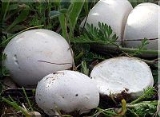
Bovista plumbea
Encyclopedia
Bovista plumbea, also referred to as the paltry puffball, is a small puffball
mushroom commonly found in Western Europe
and California
, white when young and greyish in age. Easily confused with immature Bovista dermoxantha
, it is attached to the substrate by a tuft of mycelium
.
is 1.5–3.5 cm broad, attached to the substrate by a tuft of mycelium
, and spherical to slightly compressed. The exoperidium is white, becoming buff to pale-tan
and minutely tomentose
, and sometimes areolate. It eventually flakes away, or peels off in sheets, the latter occurring at maturation in hot, dry conditions. In contrast, the endoperidium membranes are lead-grey, with or without adhering fragments of exoperidium. They often live in scattered to clustered in disturbed areas, especially in sparse grass. They are edible when young and white, but are often considered too small for eating.
s are 5.0–6.5 x 4.0–5.5 µm
, ovoid, thick-walled, and nearly smooth, with a central oil droplet, and a 7.5–11.5 µm pedicel. The capillitium is composed of individual elements, rather than interwoven, main branches thick-walled, flexuous, rapidly tapering, forking more or less dichotomously, ochre-colored in KOH.
The spores are released via a small apical pore. The gleba is white, turning dingy yellowish, olive-brown, finally dark-brown and firm-textured. However, the subgleba and sterile base are usually absent. Fruiting occurs throughout the mushroom
season.
Puffball
A puffball is a member of any of several groups of fungus in the division Basidiomycota. The puffballs were previously treated as a taxonomic group called the Gasteromycetes or Gasteromycetidae, but they are now known to be a polyphyletic assemblage. The distinguishing feature of all puffballs is...
mushroom commonly found in Western Europe
Europe
Europe is, by convention, one of the world's seven continents. Comprising the westernmost peninsula of Eurasia, Europe is generally 'divided' from Asia to its east by the watershed divides of the Ural and Caucasus Mountains, the Ural River, the Caspian and Black Seas, and the waterways connecting...
and California
California
California is a state located on the West Coast of the United States. It is by far the most populous U.S. state, and the third-largest by land area...
, white when young and greyish in age. Easily confused with immature Bovista dermoxantha
Bovista dermoxantha
Bovista dermoxantha is a small, white, nearly round puffball, recognized when young by a cottony-felty outer surface that becomes inconspicuously warted, eventually leaving fine, pallid, scales on an ochre to brown endoperidium. Bovista plumbea is similar, but has a smoother surface when young, and...
, it is attached to the substrate by a tuft of mycelium
Mycelium
thumb|right|Fungal myceliaMycelium is the vegetative part of a fungus, consisting of a mass of branching, thread-like hyphae. The mass of hyphae is sometimes called shiro, especially within the fairy ring fungi. Fungal colonies composed of mycelia are found in soil and on or within many other...
.
Description
The fruiting body of the sporocarpSporocarp (fungi)
In fungi, the sporocarp is a multicellular structure on which spore-producing structures, such as basidia or asci, are borne...
is 1.5–3.5 cm broad, attached to the substrate by a tuft of mycelium
Mycelium
thumb|right|Fungal myceliaMycelium is the vegetative part of a fungus, consisting of a mass of branching, thread-like hyphae. The mass of hyphae is sometimes called shiro, especially within the fairy ring fungi. Fungal colonies composed of mycelia are found in soil and on or within many other...
, and spherical to slightly compressed. The exoperidium is white, becoming buff to pale-tan
Tan (color)
Tan is a pale whiteish, tawny shade of white. The name is derived from tannum used in the tanning of leather.The first recorded use of tan as a shade name in English was in the year 1590....
and minutely tomentose
Tomentose
Tomentose is a term used to describe plant hairs that are flattened and matted, forming a woolly coating known as tomentum. Often the hairs are silver or gray-colored...
, and sometimes areolate. It eventually flakes away, or peels off in sheets, the latter occurring at maturation in hot, dry conditions. In contrast, the endoperidium membranes are lead-grey, with or without adhering fragments of exoperidium. They often live in scattered to clustered in disturbed areas, especially in sparse grass. They are edible when young and white, but are often considered too small for eating.
Spores
SporeSpore
In biology, a spore is a reproductive structure that is adapted for dispersal and surviving for extended periods of time in unfavorable conditions. Spores form part of the life cycles of many bacteria, plants, algae, fungi and some protozoa. According to scientist Dr...
s are 5.0–6.5 x 4.0–5.5 µm
Micrometer
A micrometer , sometimes known as a micrometer screw gauge, is a device incorporating a calibrated screw used widely for precise measurement of small distances in mechanical engineering and machining as well as most mechanical trades, along with other metrological instruments such as dial, vernier,...
, ovoid, thick-walled, and nearly smooth, with a central oil droplet, and a 7.5–11.5 µm pedicel. The capillitium is composed of individual elements, rather than interwoven, main branches thick-walled, flexuous, rapidly tapering, forking more or less dichotomously, ochre-colored in KOH.
The spores are released via a small apical pore. The gleba is white, turning dingy yellowish, olive-brown, finally dark-brown and firm-textured. However, the subgleba and sterile base are usually absent. Fruiting occurs throughout the mushroom
Mushroom
A mushroom is the fleshy, spore-bearing fruiting body of a fungus, typically produced above ground on soil or on its food source. The standard for the name "mushroom" is the cultivated white button mushroom, Agaricus bisporus; hence the word "mushroom" is most often applied to those fungi that...
season.
Synonyms
Obsolete synonyms for B. plumbea include:- Bovista ovalispora Cooke & Massee 1887
- Bovista plumbea Pers. 1796
- Bovista plumbea var. ovalispora (Cooke & Massee) F. Šmarda 1958
- Calvatia bovista (L.) Pers. 1896
- Lycoperdon bovista Sowerby 1803
- Lycoperdon plumbeum Vittad. 1842

